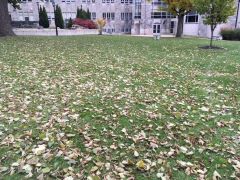ABSTRACTStudents estimate the amount of nitrogen in fallen leaves using field-collected leaves and nitrogen content values from the scientific literature. Students then estimate the cost of replacing the nitrogen content of the leaves with chemical fertilizers should the leaves be raked and removed. The overall experiment is flexible, but will generally take three class periods distributed throughout the fall semester. Activities include building and deploying leaf litter traps, collecting and drying leaves, identifying trees, and performing calculations.
AUTHORSMark E. Mitchell1 1Department of Biological and Environmental Science. Heidelberg University. 310 E. Market Street, Tiffin, OH 44883 CLASS TIMEVaries depending on how the experiment is performed and the level of students. However, you should devote approximately 1 hour for the introduction and setup of the leaf litter traps early in the fall and 1.5 hours in late fall after leaves have fallen from the trees. You will need an additional hour of class time if you plan to have students build the litterfall traps, and an additional 20 minutes of class time if students are to find their own literature sources for nitrogen content values. OUTSIDE OF CLASS TIMEVaries, however I would recommend an additional 1 hour of time outside of class. STUDENT PRODUCTSStudents will fill out a worksheet that leads them through data collection and calculations and can address further application questions. SETTINGTiming and location are essential for this study since you will be capturing leaf fall. Assuming deciduous trees are prevalent on campus, choose an area that is mostly representative of your campus grounds. I would recommend placing litterfall traps out early in the fall at the beginning of the month and then collecting leaf litter at least every 2 weeks. Ideally you will collect leaf litter throughout the fall until few leaves remain on the tree. Additional lab work includes sorting the litter, drying the litter in a drying oven (if available), and then weighing the dried leaves on a balance. COURSE CONTEXTThis experiment was performed in an introductory, non-majors environmental science lab consisting of approximately 20 students. However, the activity could be adapted for an ecology lab or advanced ecological or environmental course with incorporation of data analysis from NEON field sites. INSTITUTIONThis activity was originally taught at a small, 4-year undergraduate institution. TRANSFERABILITYThe activity was originally designed for a single lab section. However, it could be adapted to work across multiple lab sections if different areas on campus were sampled. Alternatively, the steps required could be divided and data pooled. Geography and campus terrain may limit the use and accessibility of this experiment. DOWNLOADSDescription of other Resource Files:
ACKNOWLEDGMENTSI would like to acknowledge Megan Jones, NEON, QUBES, Justin Pruneski, and my NEON-QUBES Faculty Mentoring Network for help in developing and reviewing these materials. CITATIONMark E. Mitchell. 27 April 2020, posting date. Leaf it alone: are falling leaves a burden or an economic and ecological windfall? Teaching Issues and Experiments in Ecology, Vol. 16: Experiment #1 [online]. https://tiee.esa.org/vol/v16/experiments/mitchell/abstract.html |

Leaf fall on a college campus (Photo by Mark Mitchell) full size image |
<top> | |